If you’re looking to spice up your chord progressions, you’ll want to learn about a unique chord called the minor 7 b5 chord (also known as the half diminished chord). These interesting and sophisticated chords add a jazzy and mysterious element to your playing.
In this lesson, we cover the music theory to understand how they work, guitar charts for common minor 7 b5 chords, movable shapes to give you flexibility to play them throughout the fretboard, and application examples to help you learn these versatile chords!
I’ve you haven’t learn the essential 7th chords such as the Major 7, Dominant 7, or minor 7th chords, I suggest learning those 7th chords here.
Grab your guitar and let’s get started!
Minor 7 flat 5 chord formula (also known as half diminished chords)
Half diminished chords are simply a minor 7th chord with the 5th degree lowered by a half step. As you can see below, every chord tone except for the root note is lowered by a half step.

Here are some half diminished (minor 7 b5) chord examples and what notes they include:
- C minor 7 b5 has the notes C, Eb, Gb, and Bb.
- E minor 7 b5 has the notes E, G, Bb, and D.
- G minor 7 b5 has the notes G, Bb, Db, and F.
You might also see these chords written as “m7b5” or “half dim”.
How to read the guitar chord charts
For the charts below:
- The lowest horizontal line represents the thickest string (Low E). The top horizontal line represents the thinnest string (high E).
- The vertical lines represent the frets on the guitar (thin metal lines on your guitar fretboard)
- The numbers inside the circles tell you what fingers to use to press down on your fretting hand (see the fingering chart in the following section)
Take a look at the image below to better understand the chord chart symbols.

Minor 7th b5 chord charts
Let’s look at a few chart examples of how to play common minor 7 b5 chords and then learn the movable shapes more systematically in the next section.
C minor 7 b5

D minor 7 b5

E minor 7 b5

F minor 7 b5

G minor 7 b5

A minor 7 b5
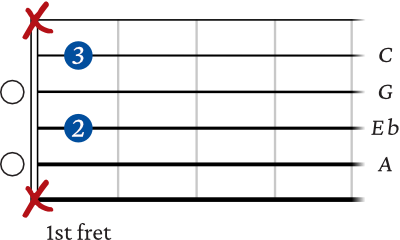
B minor 7 b5
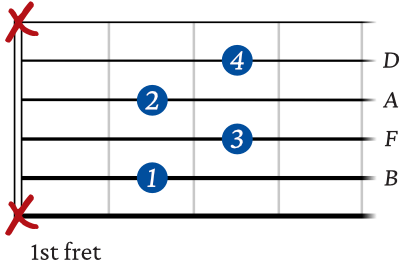
Minor 7th b5 movable shapes – 6th string
Here are the movable half diminished chord shapes starting on the 6th string. If you know the notes on the fretboard, find your root note accordingly to play any half diminished chord.

Minor 7th b5 movable shapes – 5th string

Minor 7th b5 movable shape – 4th string

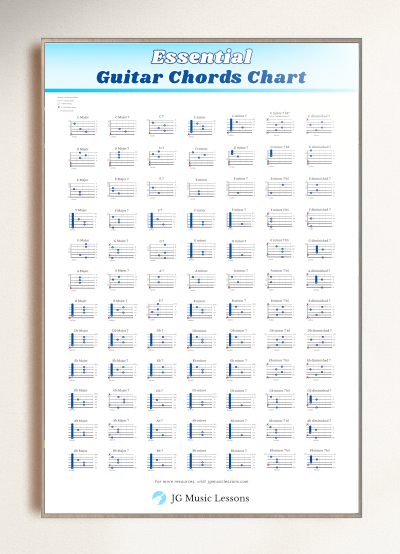
Minor 7th b5 progression examples
Finally, let’s apply these chords in a progression. The half diminished chord is typically used as the “2 chord in a minor progression” or the “7 chord” in a Major progression. See the examples below to better understand this.
The audio examples are included under the notation. You’ll hear the regular tempo and a slower tempo to help you learn each example.
Chord progression 1
Progression 1 chords are B half diminished, E 7, and A minor 7. This is would labeled as a “2 5 1” in the key of A minor. This progression is one of the bread and butter progressions used jazz.
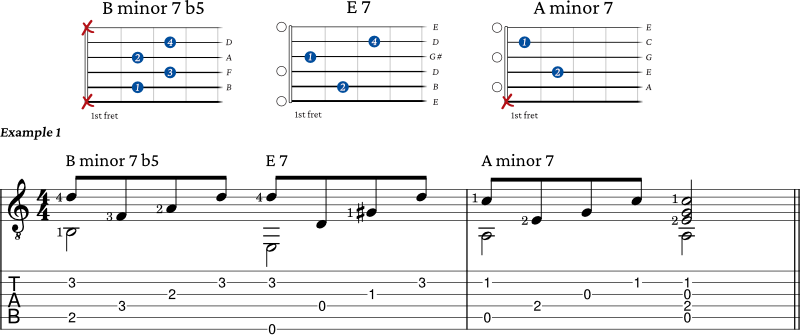
Chord progression 2
Progression 2 chords are Bb Major 7, A minor 7 b5, D 7, G minor, G minor/F#, G minor/F, and E minor 7 b5.
In this example, the A minor 7 b5 in measure 2 is the “7 chord” in the key of Bb Major or “2 chord” in G minor. The E minor 7 b5 chord in measure 4 finalizes a cliché chord movement starting on the G minor in measure 3.
Side note: G minor 6 and E minor 7 b5 share the same notes so they can be used interchangeably.

Chord progression 3
The chords in this last progression are C# minor 7 b5, C minor 7, B minor 7, E 7 (b9,13), A minor 7, F# minor 7 b5, and G Major 6 (9).
The F# minor 7 b5 in measure 3 acts as substitute for a D 7 (9) chord because it shares most of the notes.
This is a typical jazz chord progression ending. The function of the C# minor 7 b5 acts like a “2 chord” of the 3 chord in the key of G Major. We’re using a Bossa Nova rhythm to switch things up here.
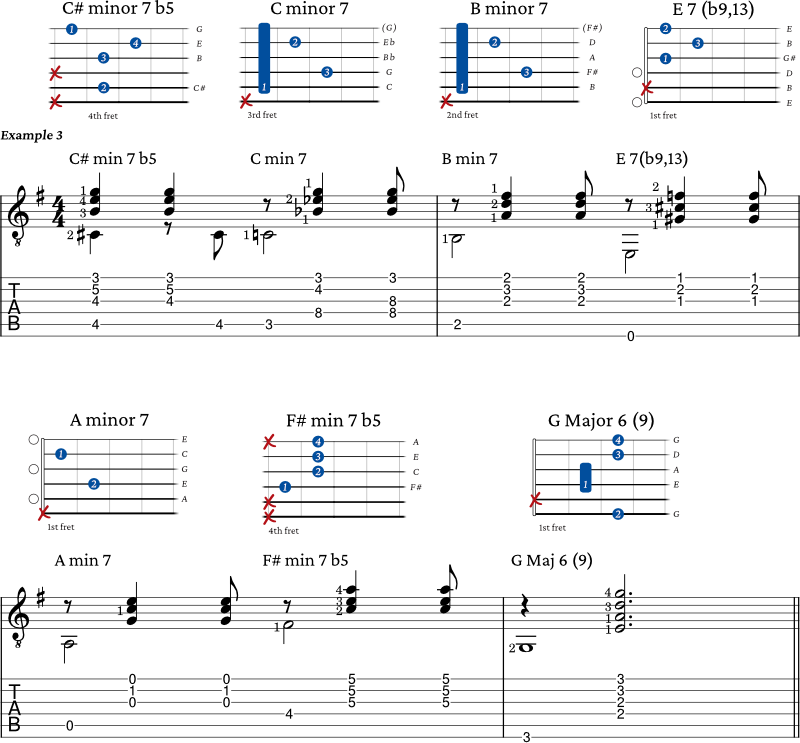
To learn other rich chords like these, check out how to play jazz chords on guitar.
Wrapping Up
We covered a lot of ground on these minor 7 b5 chords, also known as half diminished chords. We explored how they work, charts for common chords, movable shapes, and application examples to play along with. If it was a lot to take in, give yourself some time and revisit the sections that you might need to brush up in this lesson.
Learning these chords will be a powerful addition to your musical tool-belt, adding depth to your playing or when creating your music. Keep practicing, and you’ll start unlocking the potential of these versatile chords!
Level up with the free guitar practice guide here!
All the best,
JG Music Lessons
Start Playing Better, Faster
with Pro Membership! ✨
Get the guidance, tools, and support that keep your progress on track:
🏁 Always know what to practice next. Access the full Guitar Learning Roadmap with lessons in sequence.
🎼 Play songs with confidence. Step-by-step lessons of popular, classical pieces and other styles.
📙 Save time and frustration. Clear PDFs and ebooks that save time so you can focus on playing.
🎟️ Get rewarded for consistency. 2 free downloads every month (a $240+ yearly value).
🎁 Keep costs low while you grow. 50% off all charts, tracks, and posters — up to 75% off bundles.
🚫 Stay focused. Ad-free environment keeps you in the zone.
💬 Get help when you need it. Direct member support to keep you on track.

